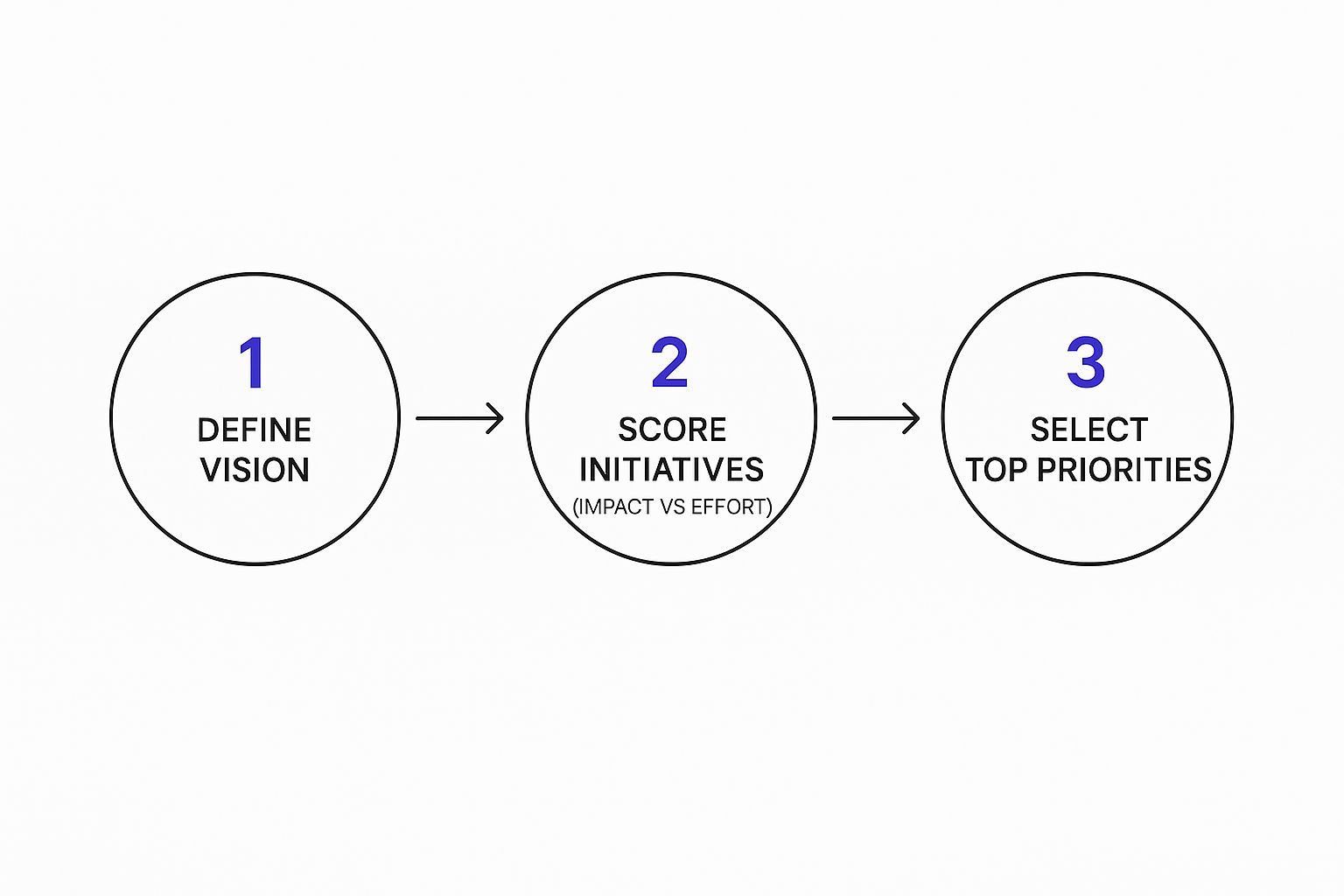Strategic planning isn't just a corporate buzzword; it’s the structured process of figuring out where your company is headed and how you'll get there. It starts with a hard look at your current situation, then moves to defining your future, creating a real plan, and finally, keeping an eye on your progress and adjusting as you go.
Building Your Foundation for a Winning Strategy

Before you can chart a course for the future, you have to know your starting point. And I mean really know it. This foundational stage is all about grounding your strategy in reality, not wishful thinking. It's so much more than a quick SWOT analysis—it's a deep, honest review of everything inside and outside your business.
This means you need to gather real, unfiltered insights from every part of your organization. For remote and hybrid teams, this is especially important. You can’t just rely on hallway conversations. Digital collaboration tools are your best friend here, making sure every voice is heard, from the customer support team on the front lines to the C-suite.
Gathering Comprehensive Insights
Start by looking in the mirror. A classic SWOT (Strengths, Weaknesses, Opportunities, Threats) analysis is a solid place to begin, but don’t let it be your only tool. To get a sharper view, consider more dynamic frameworks. For a more agile approach, you can learn more about how a Lean Canvas model helps map out your core business components.
Once you have a handle on your internal world, turn your attention outward. What are your competitors actually doing? What larger market trends could completely change the game for you next year? This external analysis is where you'll spot both hidden dangers and golden opportunities.
Here’s what to dig into:
- Customer Feedback: Go deeper than satisfaction scores. Set up interviews or use sentiment analysis on reviews to truly understand what your customers love and what keeps them up at night.
- Team Perspectives: Your team knows what's working and what's broken. Use anonymous surveys or guided brainstorming sessions in a tool like Bulby to get candid feedback on everything from internal workflows to company culture.
- Market Trends: Get your hands on industry reports and analyze competitor performance. You need to see where the market is headed, not just where it is today.
A winning strategy is built on a foundation of truth. If you aren't brutally honest about your current weaknesses and the market's realities, your plan is destined to fail before it even begins.
Pressure-Testing Your Mission
This is also the perfect time to dust off your mission and vision statements and see if they still hold up. Do they actually reflect who you are and where you’re trying to go? A mission that doesn't inspire your team is just empty words on a webpage.
This initial assessment has become a non-negotiable for successful businesses. It's no surprise that 71% of fast-growing companies have a formal strategic plan in place. This structured approach ensures your entire strategy is built on solid ground, setting you up for a much higher chance of success.
Defining Your North Star and Setting Priorities
Now that you’ve got a clear-eyed view of where you stand, it's time to figure out where you're going. This is the part where we move past fuzzy ambitions and nail down a compelling long-term vision—what I like to call the team's "North Star." Think of it as the compass that will guide every single decision your company makes from here on out.
For instance, a B2B SaaS company might decide their North Star is to capture 30% of the enterprise market in a brand-new vertical. Or, a direct-to-consumer brand might set its sights on becoming the number one sustainable choice in its category. The point isn't just to have a vague idea; it's to paint a vivid, inspiring picture of the future that gets everyone on board and paddling in the same direction.
From Big Vision to Focused Action
A big vision is great for motivation, but it's just a daydream without focus. The next, and absolutely critical, step is to prioritize. You simply can't do everything at once. Spreading your team’s energy and resources too thin is a surefire way to accomplish nothing. The real test—and where so many strategies fall apart—is making those tough calls about what truly matters right now.
This means pinpointing the handful of critical initiatives that will make the biggest difference. You need a structured way to weigh potential projects to ensure you're placing your bets on the ones most likely to pay off.
This visual breaks down a simple but powerful workflow for getting from that high-level vision to a concrete set of priorities.

Following a process like this ensures your choices are intentional. You're moving methodically from a broad vision, to a scored list of potential initiatives, and finally, to a focused roster of top priorities.
Making the Tough Calls
One of the best tools I've found for scoring potential initiatives is a classic impact versus effort matrix. It’s a simple way to visually map out which projects will give you the biggest bang for your buck and which are just resource drains in disguise.
Inside Bulby, you can run a guided session where your team collaboratively scores each idea. This keeps the process transparent and pulls from the collective wisdom in the room, which is a great way to keep individual biases from derailing the conversation.
Here’s a practical way to think about the matrix:
- High Impact, Low Effort: These are your quick wins. Jump on them immediately to build momentum and morale.
- High Impact, High Effort: These are the big, strategic projects. They need careful planning because they'll demand significant resources.
- Low Impact, Low Effort: Squeeze these in when there are gaps, but don't ever let them distract from the more important stuff.
- Low Impact, High Effort: Avoid these like the plague. They're time sinks that won't move the needle.
The essence of strategy is choosing what not to do. Prioritizing isn't just about making a list; it's about making conscious trade-offs to concentrate your force where it counts.
Using structured methods like this keeps your team’s efforts laser-focused. If you're looking for more ways to frame these big goals, take a look at our guide on various goal-setting frameworks that can help you translate your vision into measurable targets. This kind of disciplined approach is what separates strategies that succeed from those that just look good on paper.
Translating Strategy Into an Actionable Plan

A brilliant strategy is just a nice idea until you do something with it. The most critical pivot in the entire process is turning that high-level vision into a concrete, day-to-day operational roadmap. This is where ambition meets action.
This is the part where you break down your big priorities into specific, measurable outcomes. Doing this gets everyone pulling in the same direction, which is absolutely vital for remote and hybrid teams who can’t just lean over a cubicle to stay in sync. It’s all about building a clear bridge from the "why" to the "how."
Adopting a Framework for Clarity
To make your goals tangible, you need a solid framework. I've found one of the most effective methods for this is using Objectives and Key Results (OKRs). It’s a fantastic way to translate broad, sweeping goals into milestones you can actually track.
- Objective: This is your big, ambitious goal. Think of it as the inspirational statement, like, "Become the recognized leader in our new market segment."
- Key Results: These are the numbers that prove you did it. They have to be specific and measurable, such as "Achieve a 40% market share in the new segment by Q4" or "Secure 25 new enterprise clients."
A tool like Bulby can be a huge help here, allowing your team to brainstorm and define these OKRs together. Its guided exercises ensure your key results are genuinely measurable and tied directly to the main objective. This helps you sidestep the common trap of setting vague targets that no one knows how to hit.
Once you have that north star defined, the next logical step is to formalize it. This guide on how to write a business plan offers some great, actionable steps for turning that vision into a practical document.
Your strategic plan has to live in your team's daily work, not in a forgotten folder. The OKR framework transforms strategic intent into a checklist for progress, making it real for everyone.
This approach makes it crystal clear what success looks like, so every team member—no matter where they’re working from—understands how their individual effort contributes to the bigger picture.
Assigning Ownership and Resources
With clear objectives in hand, it's time to assign ownership. Every single key result needs a champion, a single person who is accountable for driving it forward. This simple step cuts through so much confusion and builds a real culture of accountability.
Let's imagine a services company launching a new consulting package to diversify its revenue.
| Key Result | Owner | Primary Resources Needed | Timeline |
|---|---|---|---|
| Develop complete service offering & materials | Head of Services | 2 Senior Consultants, Marketing Support | 6 weeks |
| Secure 5 beta clients for the new service | Sales Lead | Beta program discount budget, Legal review | 8 weeks |
| Generate 100 qualified leads via launch campaign | Marketing Manager | Ad budget, Content writer, Designer | 12 weeks |
See how that breakdown connects the strategy directly to people, budgets, and timelines? It’s no longer an abstract idea; it's a tangible project with clear responsibilities. If you’re mapping out a new product, a well-structured product roadmap template can give you the perfect foundation for this kind of detailed planning.
By getting this specific, you're embedding the strategy directly into your operations. It becomes a living guide that directs daily decisions, keeps distributed teams aligned, and gives your vision a real, actionable path to becoming a reality. This is how you close the gap between planning and doing.
Executing Your Plan and Empowering Your Team

This is the make-or-break moment. It's where a strategic plan either takes flight or ends up gathering digital dust on a server somewhere. A beautifully crafted strategy document is useless until your team is energized and pulling in the same direction.
Execution isn't about grand gestures. It's about the small, consistent, daily actions that bring your vision to life, one task at a time.
For this to work, every single person needs to see how their role fits into the bigger picture. Their individual to-do list has to connect clearly to the company’s most important goals. This is non-negotiable for remote and hybrid teams, where you can't just rely on hallway conversations to keep everyone aligned.
Fostering a Culture of Accountability
Let's be clear: real accountability isn't about pointing fingers when things go wrong. It’s about creating an environment of shared ownership where everyone is invested in the outcome. When people have clear goals and the freedom to figure out how to hit them, their commitment skyrockets.
It all starts with communication. You need to establish a steady rhythm of updates that keeps everyone in sync without bogging them down in endless meetings. It’s no surprise that 86% of organizations with a solid strategic plan saw a positive impact on revenue—clear plans create focus and accountability.
To build this culture, try these communication tactics:
- Asynchronous Updates: Use a shared dashboard in a tool like Bulby to track progress on key results. This lets everyone see the latest status in real-time without scheduling yet another call.
- Focused Check-ins: Ditch the long, rambling status meetings. Instead, hold short, weekly virtual huddles to bust through roadblocks and celebrate small wins.
- Transparent Reporting: Leadership needs to regularly share progress on the overall strategy. This reinforces why the work matters and shows how individual contributions are actually moving the needle.
A great strategy isn't just managed from the top down; it's owned from the bottom up. Empower your team by giving them the clarity, tools, and trust to execute their part of the plan.
Keeping Momentum High with a Distributed Team
Maintaining energy and focus is tough when your team is scattered across different locations and time zones. The trick is to build systems that encourage proactive engagement and make collaboration feel natural. This is where your leadership really shines.
If you want to dig deeper, we have a whole guide on building high-performance teams in a remote setting.
Inside Bulby, for instance, you can set up automated prompts that ask teams to share their weekly progress and flag any challenges. This keeps the plan top-of-mind and encourages people to help each other out, turning the strategic plan from a static document into a living, breathing team effort.
By breaking your big plan down into coordinated, daily actions, you make sure it delivers real, measurable results.
Monitoring Progress and Adapting on the Fly
https://www.youtube.com/embed/Te9mYmonVjE
A strategic plan isn't a static document you create, print, and then forget about in a binder. I’ve seen that happen far too many times. Think of it as a living, breathing roadmap for a journey where the terrain is always changing. Markets shift, new competitors pop up out of nowhere, and even your own internal priorities can pivot.
This final stage is all about building an agile system to keep your finger on the pulse, track your progress, and have the guts to make smart adjustments when things aren't going to plan. It’s about creating a powerful feedback loop so you know, without a doubt, if your actions are actually delivering results.
Choosing Metrics That Matter
To track your strategy's health, you need the right vital signs. These are your Key Performance Indicators (KPIs). Good KPIs are so much more than vanity metrics; they’re the true signals telling you if your strategy is hitting the mark or veering off a cliff.
Globally, tying KPIs to strategic planning is no longer a "nice-to-have." It’s essential for focusing a team's decisions. I've found that organizations that succeed spend about 30% of their review time looking back at performance and a full 70% planning for the future. This keeps everyone's eyes on the prize.
When you're picking your KPIs, ask these simple questions:
- Does this metric connect directly to one of our core strategic goals?
- Can we actually do something to move this number?
- Is it easy for everyone to understand and track consistently?
Data is your best friend here. It’s worth thinking about how you can use analytics to power your talent strategy to get a clearer picture of team performance and alignment.
A dashboard cluttered with meaningless numbers is just noise. Focus on the 3-5 critical KPIs that give you the clearest, most honest picture of your strategic health. That’s your signal.
To give you a starting point, here are some common KPIs broken down by business area.
Essential KPIs for Strategic Plan Monitoring
A breakdown of key performance indicators across different business functions to effectively track strategic progress.
| Business Area | Example KPI | What It Measures |
|---|---|---|
| Sales | Customer Lifetime Value (CLV) | The total revenue a business can expect from a single customer account. |
| Marketing | Customer Acquisition Cost (CAC) | The cost associated with convincing a consumer to buy a product or service. |
| Product | Net Promoter Score (NPS) | Customer loyalty and satisfaction by asking how likely they are to recommend you. |
| Finance | Monthly Recurring Revenue (MRR) | The predictable revenue a company can expect to receive every month. |
| HR/People | Employee Turnover Rate | The percentage of employees who leave the organization during a specific period. |
Remember, these are just examples. The right KPIs are the ones that are deeply tied to your unique strategic goals.
The Power of the Quarterly Business Review
From my experience, the most effective rhythm for a strategic check-in is the Quarterly Business Review (QBR). This isn't just another status meeting to sit through. It should be a dedicated, no-nonsense session where leaders can analyze performance, face the hard truths, and make clear decisions for the next 90 days.
For remote and hybrid teams, this is where a tool like Bulby really shines. You can use its templates to collect data and insights from everyone before the meeting. That way, the live session isn't spent reading slides—it’s focused entirely on high-level discussion and making the tough calls.
A well-run QBR always leads to action. You might decide to pour more resources into something that's working, pivot away from a failing initiative, or reallocate your team to jump on a new opportunity.
This is one of the core project management best practices that separates the teams that win from those that just stay busy. This constant cycle of measuring, learning, and adapting is what turns a good plan into a great one.
Answering Your Top Strategic Planning Questions
Even with the best road map, a few questions always pop up along the way. Let's dig into some of the most common ones I hear from teams as they start putting their strategic plans together.
How Often Should We Revisit Our Strategic Plan?
Your strategic plan shouldn't be a "set it and forget it" document gathering dust on a server somewhere. Think of it more like a living guide. While your core vision and mission should be pretty stable, the plan itself needs regular check-ups to stay effective.
I've found that a full, deep-dive review works best annually. This is your big moment to zoom out, reassess the market, and lock in major priorities for the next 12 months.
But you can't wait a whole year to see if you're on track. You need to check your progress much more often. A quarterly rhythm is perfect for reviewing your key initiatives and metrics. These check-ins are crucial—they give you the agility to react to a new competitor or seize a surprise opportunity without getting derailed from your long-term goals.
For teams in really fast-paced industries, a quick monthly pulse-check on your main KPIs is a brilliant move.
What’s the Single Biggest Mistake Teams Make?
Hands down, the most common and damaging mistake is crafting a beautiful plan that never actually gets implemented. I've seen it happen time and time again: companies pour countless hours into creating a "perfect" strategy deck, only for it to be filed away and completely ignored by the very people needed to make it happen.
This disconnect happens when there's no clear bridge between the high-level goals and the day-to-day work of the team. To make sure your plan doesn't end up in the graveyard of good intentions, you have to put just as much effort into communication and execution as you do into the initial brainstorming.
A strategy is only as good as its execution. If your team doesn't see how their daily work connects to the company's vision, the plan has already failed.
How Do We Get Our Whole Remote Team Involved?
Getting your distributed team involved from the very beginning is the secret sauce for genuine buy-in. It's simple: when people feel like they've had a say in creating the plan, they become its biggest advocates. Digital tools make this easier than ever.
Here’s a practical way to approach it:
- Kick things off with a brainstorm. Use anonymous surveys or a shared digital whiteboard in a tool like Bulby to get everyone's honest take on the company’s strengths, weaknesses, and potential opportunities. Anonymity often brings out the most candid feedback.
- Run focused virtual workshops. Instead of one giant, unwieldy meeting, hold smaller sessions for specific departments. This lets you dive into the goals and challenges that are most relevant to their specific roles.
- Keep everything transparent. As the plan starts coming together, use a central, shared space to house all the working documents. This simple step goes a long way in preventing the "decisions are being made behind closed doors" feeling.
- Launch it with real energy. Don't just send an email. Unveil the final plan in a company-wide virtual all-hands meeting. The goal is to passionately explain how each person’s contribution is essential to bringing that shared vision to life.
Ready to make your strategic planning sessions more creative and inclusive, especially with a remote team? Bulby provides guided, AI-powered brainstorming exercises that ensure every voice is heard and your best ideas come to life. Explore how Bulby can transform your next strategy meeting.

